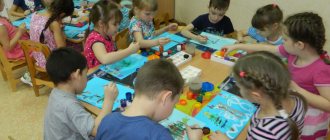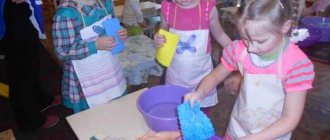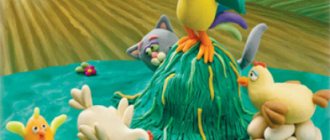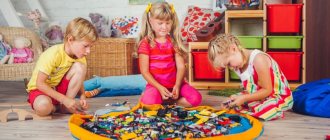ECD "Introduction to Music" in the preparatory group
Summary of a music lesson in a preparatory group in accordance with the Federal State Educational Standard
I. Organizational information
1. Dominant educational field
Artistic and aesthetic development According to the Federal State Educational Standard for Education
2. Type of children's activity
: Playful, communicative, cognitive, musical and artistic, perception of classical music, motor.
II. Methodological information
1. Theme of educational activities
Introducing preschool children to the perception of Russian classical music through the use of ICT
2. Methods and techniques for implementing the lesson content:
Visual (Demonstration of didactic material, showing a musical presentation,)
Verbal (Tale about musical images, musical instruments)
Practical (exercise, game, musical-rhythmic movements, music perception)
3. Integration of educational areas
Social and communicative development - children recognize the musical instruments of a symphony orchestra.
Cognitive development introducing children to classical music. Screening of the presentation “Waltz of the Flowers” “December” music by Tchaikovsky story
Speech development: Expansion of active vocabulary (symphony orchestra, ballet)
Physical development: Development of motor activity in dancing and games
4. Age group:
Preparatory
5. Target
: Formation Introducing preschool children to the perception of Russian classical music through the use of ICT
6. Tasks
:
6.1Arouse and maintain interest in works of a classical nature.
6.2 Develop creative imagination, musical memory, musical taste. Develop the character of the music, change movements in accordance with the character of the music, take an active part in the game. Develop rhythmic perception of classical music
6.3 Cultivate interest in the sound of musical instruments in a symphony orchestra. Listen and hear.
7. Planned results
7.1 Ideas about the instruments of a symphony orchestra have been formed
7.2 Able to distinguish the sound of a harp, horn from the sound of other instruments, independently change movements in accordance with the nature of the music, takes an active part in the game.
8. Organization of the environment for conducting classes
(educational activities) Illustrations (musical instruments, balalaika, tambourines, piano, musical music by P. I. Tchaikovsky
Computer, projector)
9. Preparation for educational activities
(in class, during special moments) Viewing in a group a presentation with illustrations of musical instruments familiar to children
Lesson notes
(educational activities)
I. Introductory part
Introduction to the topic (creating a problem situation) Showing a music box, the arrival of the fairy of music, musical riddles.
Question for the children: do they know what ballet is called?
From the teacher's story, children will learn about Tchaikovsky's ballet "The Nutcracker" (
1.2 Motivation for children's activities
Perception of music
“Waltz of Snow Flakes” “Waltz of Flowers “December”. I. Tchaikovsky
determination of the authorship of the music (vocal, instrumental, compositional, nature of the music, sound (what instrument is performed on).
1.3 Goal setting
(with the help of the teacher, children formulate the goal of their activity or accept the goal of the teacher) The music was performed by a symphony orchestra, and we can also play in the orchestra!
II. Main part:
2.1 Updating previously acquired knowledge Remember what other musical instruments children know. What groups make up a symphony orchestra?
2.2 Acquisition (communication and acceptance) of new knowledge
Learning a song
“New Year’s Round Dance” music by T Popatenko
Musical and didactic game “What do I play?” using familiar card tools
Finger gymnastics, breathing exercise
2.3 Independent activities of children to consolidate new knowledge
Folk game "Granny the Hedgehog". (“Baba Yaga”) music by Tchaikovsky Children independently perform familiar dance movements to the music of Tchaikovsky (“Game of Horses.” “New Doll”, March of Wooden Soldiers “Kamarinskaya” perform dance movements)
“Waltz of Snow Flakes” dance of snowflakes music by Tchaikovsky
III. Final part
3.1 Analysis and self-analysis of children's activities
Children answer questions about what they listened to, riddles of the music fairy. Musical “Guessing Game” based on the works of Tchaikovsky.
IV. Further development of the topic
4.1 Continue the theme of classical music." Symphony orchestra performance in kindergarten
4.2 Holiday “Three Whales in Music”
Bibliography:
1 “Music. Classes for children of senior and preparatory groups"
2. Minina E. A. “Musical development of children 3-5 years old in kindergarten”: Lesson notes, repertoire, criteria for assessing results. /E. A. Minina. – Yaroslavl: Academy of Development, 2009. -256 p.
Introspection
1. Dominant educational field
Artistic and aesthetic development According to the Federal State Educational Standard for Education
2. Type of children's activity
: Gaming, communicative, cognitive, musical and artistic, perception, classical music, motor.
3. Methods and techniques for implementing the lesson content:
Visual (Demonstration of illustrations, Verbal (riddles, appearance of the music fairy)
Practical (exercise, game, musical-rhythmic movements, perception of music from the ballet “The Nutcracker” Finger gymnastics. Dynamic exercise)
4. Integration of educational areas
Social and communicative development - children will learn a story about a ballet about the musical instruments of a symphony orchestra,
Cognitive development: introducing children to musical instruments, listening to works from the ballet “The Nutcracker”, Seasons “December” presentations.
Speech development: Expansion of active vocabulary (symphony orchestra, ballet)
Physical development: Development of motor activity in dancing and games
5. Age group:
Preparatory
6. Target
: Introducing preschool children to the perception of Russian classical music through the use of ICT
6. Task
1Arouse and maintain interest in works of a classical nature. Talk about ballet.
6.2 Develop creative imagination, musical memory, musical taste, develop the character of the music, change movements in accordance with the character of the music, take an active part in the game. Develop rhythmic perception
6.3 Cultivate interest in the sound of musical instruments in a symphony orchestra.





